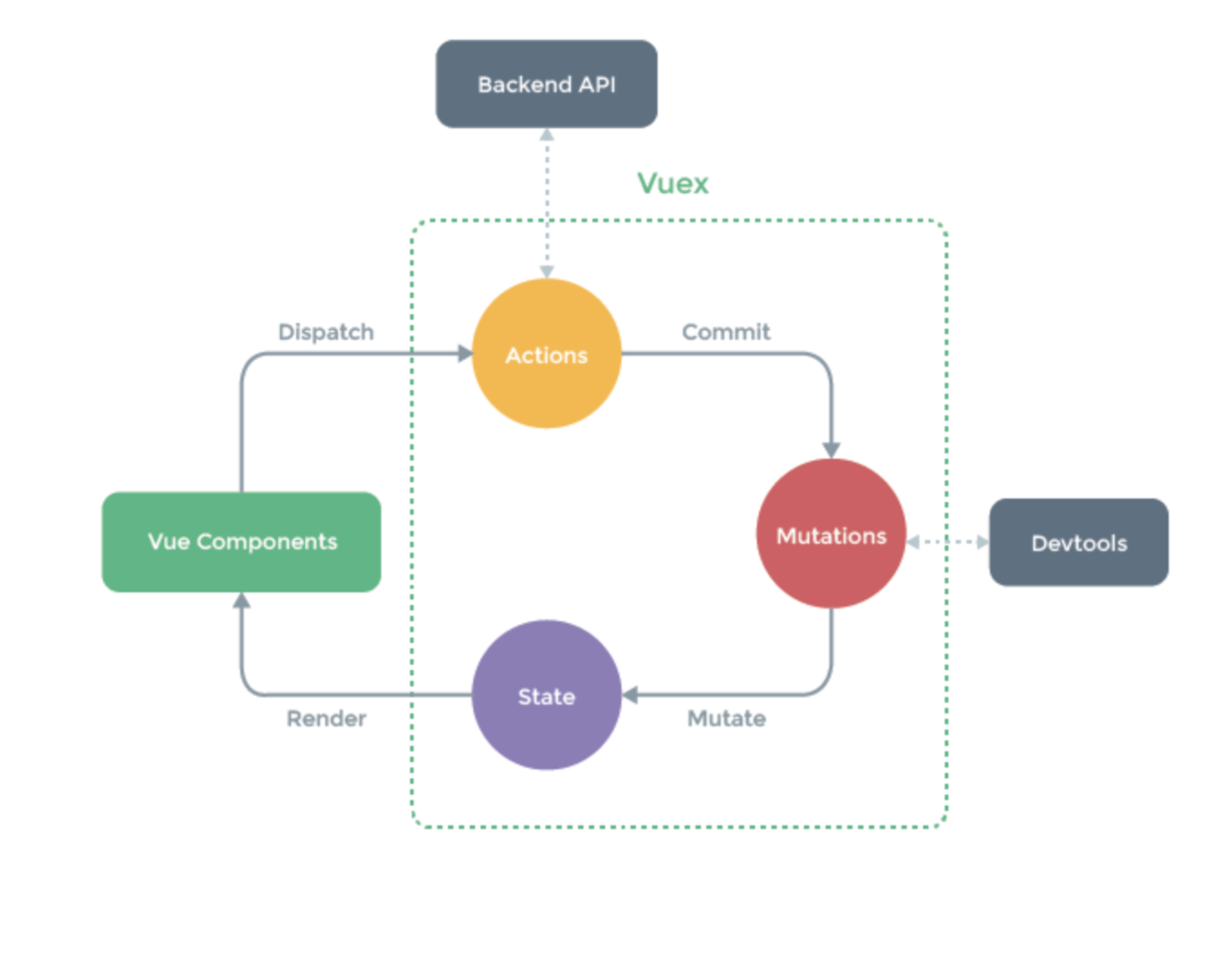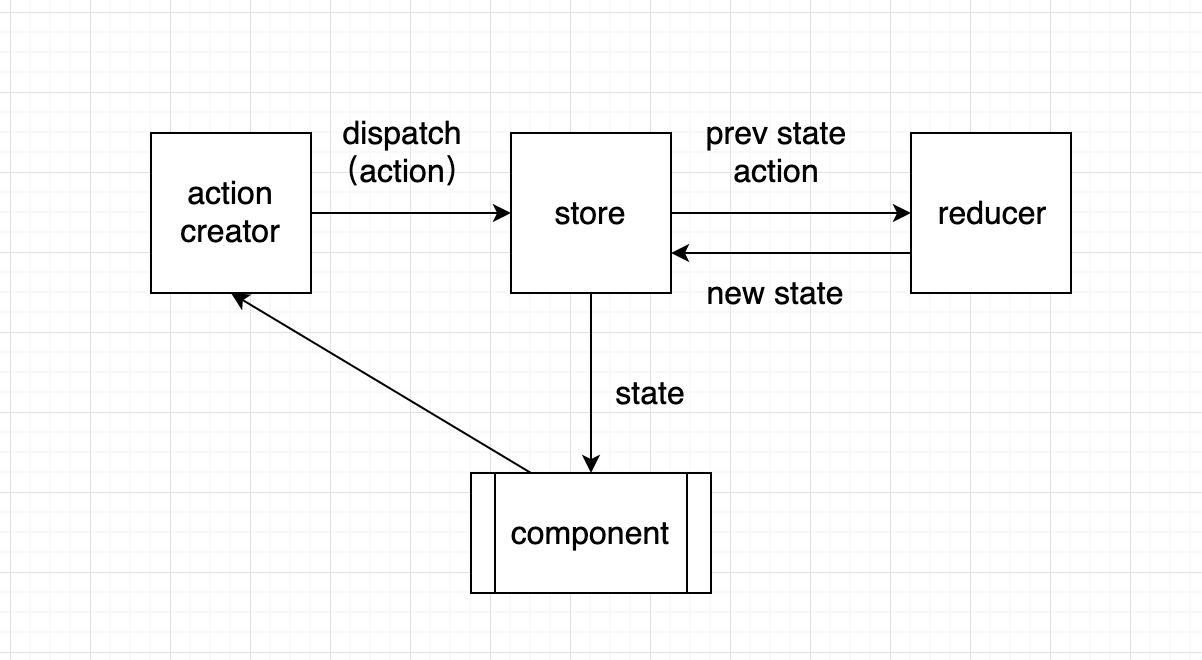前言:最近接触到一种新的(对我个人而言)状态管理方式,它没有采用现有的开源库,如redux、mobx等,也没有使用传统的useContext,而是用useState + useEffect写了一个发布订阅者模式进行状态管理,这一点对我来说感觉比较新奇,以前从没接触过这种写法,于是决定研究一下目前比较常用的状态管理方式。
ps:这里谈到的状态管理是指全局状态管理,局部的使用useState即可
状态管理方式
目前比较常用的状态管理方式有hooks、redux、mobx三种,下面我将详细介绍一下这三类的使用方法以及分析各自的优缺点,以供各位进行参考。
Hooks状态管理
用hooks进行状态管理主要有两种方式:
- useContext+useReducer
- useState+useEffect
useContext+useReducer
使用方法
1.创建store和reducer以及全局context
src/store/reducer.ts
import React from "react";
// 初始状态
export const state = {
count: 0,
name: "ry",
};
// reducer 用于修改状态
export const reducer = (state, action) => {
const { type, payload } = action;
switch (type) {
case "ModifyCount":
return {
...state,
count: payload,
};
case "ModifyName":
return {
...state,
name: payload,
};
default: {
return state;
}
}
};
export const GlobalContext = React.createContext(null);2.根组件通过 Provider 注入 context
src/App.tsx
import React, { useReducer } from "react";
import './index.less'
import { state as initState, reducer, GlobalContext} from './store/reducer'
import Count from './components/Count'
import Name from './components/Name'
export default function () {
const [state, dispatch] = useReducer(reducer, initState);
return (
<div>
<GlobalContext.Provider value={{state, dispatch}}>
<Count />
<Name />
</GlobalContext.Provider>
</div>
)
}3.在组件中使用
src/components/Count/index.tsx
import { GlobalContext } from "@/store/reducer";
import React, { FC, useContext } from "react";
const Count: FC = () => {
const ctx = useContext(GlobalContext)
return (
<div>
<p>count:{ctx.state.count}</p>
<button onClick={() => ctx.dispatch({ type: "ModifyCount", payload: ctx.state.count+1 })}>+1</button>
</div>
);
};
export default Count;src/components/Name/index.tsx
import { GlobalContext } from "@/store/reducer";
import React, { FC, useContext } from "react";
const Name: FC = () => {
const ctx = useContext(GlobalContext)
console.log("NameRerendered")
return (
<div>
<p>name:{ctx.state.name}</p>
</div>
);
};
export default Name;useState+useEffect
使用方法
1.创建state和reducer
src/global-states.ts
// 初始state
let globalState: GlobalStates = {
count: 0,
name: 'ry'
}
// reducer
export const modifyGlobalStates = (
operation: GlobalStatesModificationType, payload: any
) => {
switch (operation) {
case GlobalStatesModificationType.MODIFY_COUNT:
globalState = Object.assign({}, globalState, { count: payload })
break
case GlobalStatesModificationType.MODIFY_NAME:
globalState = Object.assign({}, globalState, { name: payload })
break
}
broadcast()
}参考 前端进阶面试题详细解答
src/global-states.type.ts
export interface GlobalStates {
count: number;
name: string;
}
export enum GlobalStatesModificationType {
MODIFY_COUNT,
MODIFY_NAME
}2.写一个发布订阅模式,让组件订阅globalState
src/global-states.ts
import { useState, useEffect } from 'react'
import {
GlobalStates,
GlobalStatesModificationType
} from './global-states.type'
let listeners = []
let globalState: GlobalStates = {
count: 0,
name: 'ry'
}
// 发布,所有订阅者收到消息,执行setState重新渲染
const broadcast = () => {
listeners.forEach((listener) => {
listener(globalState)
})
}
export const modifyGlobalStates = (
operation: GlobalStatesModificationType, payload: any
) => {
switch (operation) {
case GlobalStatesModificationType.MODIFY_COUNT:
globalState = Object.assign({}, globalState, { count: payload })
break
case GlobalStatesModificationType.MODIFY_NAME:
globalState = Object.assign({}, globalState, { name: payload })
break
}
// 状态改变即发布
broadcast()
}
// useEffect + useState实现发布订阅
export const useGlobalStates = () => {
const [value, newListener] = useState(globalState)
useEffect(() => {
// newListener是新的订阅者
listeners.push(newListener)
// 组件卸载取消订阅
return () => {
listeners = listeners.filter((listener) => listener !== newListener)
}
})
return value
}3.组件中使用
src/App.tsx
import React from 'react'
import './index.less'
import Count from './components/Count'
import Name from './components/Name'
export default function () {
return (
<div>
<Count />
<Name />
</div>
)
}src/components/Count/index.tsx
import React, { FC } from 'react'
import { useGlobalStates, modifyGlobalStates } from '@/store/global-states'
import { GlobalStatesModificationType } from '@/store/global-states.type'
const Count: FC = () => {
// 调用useGlobalStates()即订阅globalStates()
const { count } = useGlobalStates()
return (
<div>
<p>count:{count}</p>
<button
onClick={() =>
modifyGlobalStates( GlobalStatesModificationType.MODIFY_COUNT, count + 1 ) } > +1 </button>
</div>
)
}
export default Countsrc/components/Name/index.tsx
import React, { FC } from 'react'
import { useGlobalStates } from '@/store/global-states'
const Count: FC = () => {
const { name } = useGlobalStates()
console.log('NameRerendered')
return (
<div>
<p>name:{name}</p>
</div>
)
}
export default Count优缺点分析
由于以上两种都是采用hooks进行状态管理,这里统一进行分析,
优点
- 代码比较简洁,如果你的项目比较简单,只有少部分状态需要提升到全局,大部分组件依旧通过本地状态来进行管理。这时,使用 hookst进行状态管理就挺不错的。杀鸡焉用牛刀。
缺点
- 两种hooks管理方式都有一个很明显的缺点,会产生大量的无效rerender,如上例中的Count和Name组件,当state.count改变后,Name组件也会rerender,尽管他没有使用到state.count。这在大型项目中无疑是效率比较低的。
Redux状态管理
使用方法:
1.引入redux
yarn add redux react-redux @types/react-redux redux-thunk2.新建reducer
在src/store/reducers文件夹下新建addReducer.ts(可建立多个reducer)
import * as types from '../action.types'
import { AnyAction } from 'redux'
// 定义参数接口
export interface AddState {
count: number
name: string
}
// 初始化state
let initialState: AddState = {
count: 0,
name: 'ry'
}
// 返回一个reducer
export default (state: AddState = initialState, action: AnyAction): AddState => {
switch (action.type) {
case types.ADD:
return { ...state, count: state.count + action.payload }
default:
return state
}
}在src/stores文件夹下新建action.types.ts
主要用于声明action类型
export const ADD = 'ADD'
export const DELETE = 'DELETE'3.合并reducer
在src/store/reducers文件夹下新建index.ts
import { combineReducers, ReducersMapObject, AnyAction, Reducer } from 'redux'
import addReducer, { AddState } from './addReducer'
// 如有多个reducer则合并reducers,模块化
export interface CombinedState {
addReducer: AddState
}
const reducers: ReducersMapObject<CombinedState, AnyAction> = {
addReducer
}
const reducer: Reducer<CombinedState, AnyAction> = combineReducers(reducers)
export default reducer3.创建store
在src/stores文件夹下新建index.ts
import {
createStore,
applyMiddleware,
StoreEnhancer,
StoreEnhancerStoreCreator,
Store
} from 'redux'
import thunk from 'redux-thunk'
import reducer from './reducers'
// 生成store增强器
const storeEnhancer: StoreEnhancer = applyMiddleware(thunk)
const storeEnhancerStoreCreator: StoreEnhancerStoreCreator = storeEnhancer(createStore)
const store: Store = storeEnhancerStoreCreator(reducer)
export default store4.根组件通过 Provider 注入 store
src/index.tsx(用provider将App.tsx包起来)
import React from 'react'
import ReactDOM from 'react-dom'
import App from './App'
import { Provider } from 'react-redux'
import store from './store'
ReactDOM.render(
<Provider store={store}>
<App />
</Provider>,
document.getElementById('root')
)5.在组件中使用
src/somponents/Count/index.tsx
import React, { FC } from 'react'
import { connect } from 'react-redux'
import { Dispatch } from 'redux'
import { AddState } from 'src/store/reducers/addReducer'
import { CombinedState } from 'src/store/reducers'
import * as types from '@/store/action.types'
// 声明参数接口
interface Props {
count: number
add: (num: number) => void
}
// ReturnType获取函数返回值类型,&交叉类型(用于多类型合并)
// type Props = ReturnType<typeof mapStateToProps> & ReturnType<typeof mapDispatchToProps>
const Count: FC<Props> = (props) => {
const { count, add } = props
return (
<div>
<p>count: {count}</p>
<button onClick={() => add(5)}>addCount</button>
</div>
)
}
// 这里相当于自己手动做了映射,只有这里映射到的属性变化,组件才会rerender
const mapStateToProps = (state: CombinedState) => ({
count: state.addReducer.count
})
const mapDispatchToProps = (dispatch: Dispatch) => {
return {
add(num: number = 1) {
// payload为参数
dispatch({ type: types.ADD, payload: num })
}
}
}
export default connect(mapStateToProps, mapDispatchToProps)(Count)src/somponents/Name/index.tsx
import React, { FC } from 'react'
import { connect } from 'react-redux'
import { Dispatch } from 'redux'
import { AddState } from 'src/store/reducers/addReducer'
import { CombinedState } from 'src/store/reducers'
import * as types from '@/store/action.types'
// 声明参数接口
interface Props {
name: string
}
const Name: FC<Props> = (props) => {
const { name } = props
console.log('NameRerendered')
return (
<div>
<p>name: {name}</p>
</div>
)
}
// name变化组件才会rerender
const mapStateToProps = (state: CombinedState) => ({
name: state.addReducer.name
})
// addReducer内任意属性变化组件都会rerender
// const mapStateToProps = (state: CombinedState) => state.addReducer
export default connect(mapStateToProps)(Name)优缺点分析
优点
- 组件会订阅store中具体的某个属性【mapStateToProps手动完成】,只要当属性变化时,组件才会rerender,渲染效率较高
- 流程规范,按照官方推荐的规范和结合团队风格打造一套属于自己的流程。
- 配套工具比较齐全redux-thunk支持异步,redux-devtools支持调试
- 可以自定义各种中间件
缺点
- state+action+reducer的方式不太好理解,不太直观
- 非常啰嗦,为了一个功能又要写reducer又要写action,还要写一个文件定义actionType,显得很麻烦
- 使用体感非常差,每个用到全局状态的组件都得写一个mapStateToProps和mapDispatchToProps,然后用connect包一层,我就简单用个状态而已,咋就这么复杂呢
- 当然还有一堆的引入文件,100行的代码用了redux可以变成120行,不过换个角度来说这也算增加了自己的代码量
- 好像除了复杂也没什么缺点了
Mobx状态管理
常规使用(mobx-react)
使用方法
1.引入mobx
yarn add mobx mobx-react -D2.创建store
在/src/store目录下创建你要用到的store(在这里使用多个store进行演示)
例如:
store1.ts
import { observable, action, makeObservable } from 'mobx'
class Store1 {
constructor() {
makeObservable(this) //mobx6.0之后必须要加上这一句
}
@observable
count = 0
@observable
name = 'ry'
@action
addCount = () => {
this.count += 1
}
}
const store1 = new Store1()
export default store1store2.ts
这里使用 makeAutoObservable代替了makeObservable,这样就不用对每个state和action进行修饰了(两个方法都可,自行选择)
import { makeAutoObservable } from 'mobx'
class Store2 {
constructor() {
// mobx6.0之后必须要加上这一句
makeAutoObservable(this)
}
time = 11111111110
}
const store2 = new Store2()
export default store23.导出store
src/store/index.ts
import store1 from './store1'
import store2 from './store2'
export const store = { store1, store2 }4.根组件通过 Provider 注入 store
src/index.tsx(用provider将App.tsx包起来)
import React from 'react'
import ReactDOM from 'react-dom'
import App from './App'
import store from './store'
import { Provider } from 'mobx-react'
ReactDOM.render(
<Provider {...store}>
<App />
</Provider>,
document.getElementById('root')
)5.在组件中使用
src/somponents/Count/index.tsx
import React, { FC } from 'react'
import { observer, inject } from 'mobx-react'
// 类组件用装饰器注入,方法如下
// @inject('store1')
// @observer
interface Props {
store1?: any
}
const Count: FC<Props> = (props) => {
const { count, addCount } = props.store1
return (
<div>
<p>count: {count}</p>
<button onClick={addCount}>addCount</button>
</div>
)
}
// 函数组件用Hoc,方法如下(本文统一使用函数组件)
export default inject('store1')(observer(Count))src/components/Name/index.tsx
import React, { FC } from 'react'
import { observer, inject } from 'mobx-react'
interface Props {
store1?: any
}
const Name: FC<Props> = (props) => {
const { name } = props.store1
console.log('NameRerendered')
return (
<div>
<p>name: {name}</p>
</div>
)
}
// 函数组件用Hoc,方法如下(本文统一使用函数组件)
export default inject('store1')(observer(Name))优缺点分析:
优点:
- 组件会自动订阅store中具体的某个属性,无需手动订阅噢!【下文会简单介绍下原理】只有当订阅的属性变化时,组件才会rerender,渲染效率较高
- 一个store即写state,也写action,这种方式便于理解,并且代码量也会少一些
缺点:
- 当我们选择的技术栈是React+Typescript+Mobx时,这种使用方式有一个非常明显的缺点,引入的store必须要在props的type或interface定义过后才能使用(会增加不少代码量),而且还必须指定这个store为可选的,否则会报错(因为父组件其实没有传递这个prop给子组件),这样做还可能会致使对store取值时,提示可能为undefined,虽然能够用“!”排除undefined,可是这种作法并不优雅。
最佳实践(mobx+hooks)
使用方法
1.引入mobx
同上
2.创建store
同上
3.导出store(结合useContext)
src/store/index.ts
import React from 'react'
import store1 from './store1'
import store2 from './store2'
// 导出store1
export const storeContext1 = React.createContext(store1)
export const useStore1 = () => React.useContext(storeContext1)
// 导出store2
export const storeContext2 = React.createContext(store2)
export const useStore2 = () => React.useContext(storeContext2)4.在组件中使用
无需使用Provider注入根组件
src/somponents/Count/index.tsx
import React, { FC } from 'react'
import { observer } from 'mobx-react'
import { useStore1 } from '@/store/'
// 类组件可用装饰器,方法如下
// @observer
const Count: FC = () => {
const { count, addCount } = useStore1()
return (
<div>
<p>count: {count}</p>
<button onClick={addCount}>addCount</button>
</div>
)
}
// 函数组件用Hoc,方法如下(本文统一使用函数组件)
export default observer(Count)src/components/Name/index.tsx
import React, { FC } from 'react'
import { observer } from 'mobx-react'
import { useStore1 } from '@/store/'
const Name: FC = () => {
const { name } = useStore1()
console.log('NameRerendered')
return (
<div>
<p>name: {name}</p>
</div>
)
}
export default observer(Name)优缺点分析:
优点:
- 学习成本少,基础知识非常简单,跟 Vue 一样的核心原理,响应式编程。
- 一个store即写state,也写action,这种方式便于理解
- 组件会自动订阅store中具体的某个属性,只要当属性变化时,组件才会rerender,渲染效率较高
- 成功避免了上一种使用方式的缺点,不用对使用的store进行interface或type声明!
- 内置异步action操作方式
- 代码量真的很少,使用很简单有没有,强烈推荐!
缺点:
- 过于自由:Mobx提供的约定及模版代码很少,这导致开发代码编写很自由,如果不做一些约定,比较容易导致团队代码风格不统一,团队建议启用严格模式!
- 使用方式过于简单
Mobx自动订阅实现原理
基本概念
Observable //被观察者,状态
Observer //观察者,组件
Reaction //响应,是一类的特殊的 Derivation,可以注册响应函数,使之在条件满足时自动执行。建立依赖
我们给组件包的一层observer实现了这个功能
export default observer(Name)组件每次mount和update时都会执行一遍useObserver函数,useObserver函数中通过reaction.track进行依赖收集,将该组件加到该Observable变量的依赖中(bindDependencies)。
// fn = function () { return baseComponent(props, ref);
export function useObserver(fn, baseComponentName) {
...
var rendering;
var exception;
reaction.track(function () {
try {
rendering = fn();
}
catch (e) {
exception = e;
}
});
if (exception) {
throw exception; // re-throw any exceptions caught during rendering
}
return rendering;
}reaction.track()
_proto.track = function track(fn) {
// 开始收集
startBatch();
var result = trackDerivedFunction(this, fn, undefined);
// 结束收集
endBatch();
};reaction.track里面的核心内容是trackDerivedFunction
function trackDerivedFunction<T>(derivation: IDerivation, f: () => T, context: any) {
...
let result
// 执行回调f,触发了变量(即组件的参数)的 get,从而获取 dep【收集依赖】
if (globalState.disableErrorBoundaries === true) {
result = f.call(context)
} else {
try {
result = f.call(context)
} catch (e) {
result = new CaughtException(e)
}
}
globalState.trackingDerivation = prevTracking
// 给 observable 绑定 derivation
bindDependencies(derivation)
...
return result
}触发依赖
Observable(被观察者,状态)修改后,会调用它的set方法,然后再依次执行该Observable之前收集的依赖函数,触发rerender。
组件更新
用组件更新来简单阐述总结一下:mobx的执行原理。
- observer这个装饰器(也可以是Hoc),对React组件的render方法进行track。
- 将render方法,加入到各个observable的依赖中。当observable发生变化,track方法就会执行。
- track中,还是先进行依赖收集,调用forceUpdate去更新组件,然后结束依赖收集。
每次都进行依赖收集的原因是,每次执行依赖可能会发生变化
总结
简单总结了一下目前较为常用的状态管理方式,我个人最喜欢的使用方式是Mobx+Hooks,简单轻量易上手。各位可以根据自己的需求选择适合自己项目的管理方式。









